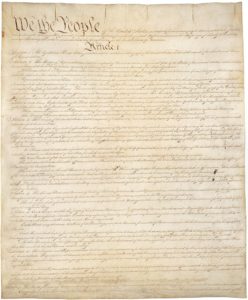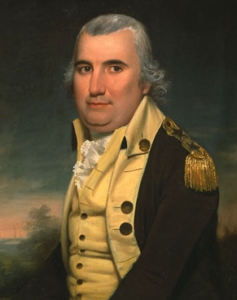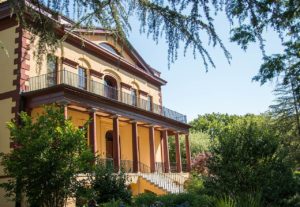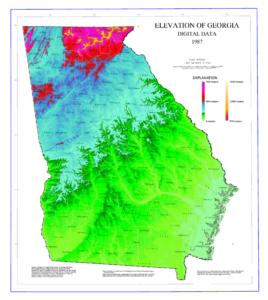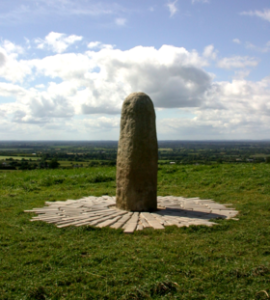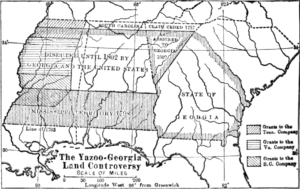We could have titled this module “South Carolina Upcountry Deep South Culture Makes its Peace with the Barbadian/Federalist South Carolina Political Culture.
Formation of the Cotton Belt Deep South Political Culture Part B describes integration of the new Piedmont fusion-deference culture with the Barbadian/Tidewater/Federalist political culture. The latter culture co-existed and dominated the larger state policy systems since the American Revolution. The South Carolina integration was replicated in Georgia; it too is described in an topic-section below. The two examples support our position that political culture, political structures, and the utility of policy systems is a viable vehicle for understanding the history of American state and local economic development.
In this module the reader is introduced to the important role played by “policy system change” in the development of the Deep South political culture and the formation of the future southern Cotton Belt. Having evolved itself in the Piedmont Upcountry, the budding Deep South fusion political culture directly challenged the here-to-fore dominant Barbadian-Federalist political culture that ruled South Carolina since its entry into the federal republic.
The struggle and eventual accommodation of these two cultures included a hotly-contested debate on several key state constitutional sections concerning elections and electoral districts–key constitutional elements that underpin both state policy system and local policy systems. The important trigger which generated this struggle was the resolution of political inequality, caused by election district malapportionment, that prevented Upcountry from breaking its geographical and economic isolation through public and private internal improvements and canal-building. Economic development policy was not a mere bystander in this cultural and political integration.
Economic development, as a policy output of a state or local policy system, is intricately linked to the culture, operations, actors, agendas and dynamics of the policy system, but ED policy can also be a major, occasionally principal dynamic that leads to change in an existing policy system and its replacement by another. Economic development is, of course, only one policy area capable of launching policy system change, but as the reader will see in the various Themes of this history, economic development can be a prominent change agent for policy system change.
Policy system change in any case, is likely to produce distinctive MED/CD goals, strategies and programs and as the reader shall see, we can witness the evolution of a given state or local policy system through time by the passage of a series of policy systems. By watching this evolution of policy systems the reader can see how ED changes over time, and has a mechanism for understanding how, why, and who caused this change. Understanding the dynamic and variegated flow of ED policy over time, can provide valuable insight to a practicing economic developer, and to a Policy World analyst.
In any case, this module case study will suggest the close potential interrelationship of political structures such as elections and policy districts in the making of ED-relevant policy. To construct internal improvements and eventually build canals to link Upcountry to the Lowland port, the state legislature was compelled through constitutional amendment to change election district representation, with accompanying partisan realignment, in order to achieve its goals and strategies.
Integration of Upcountry into the State Economy and Policy System
In this turbulent time, proposed solutions to South Carolina’s Upcountry economic disruptions ran afoul of the South Carolina state legislature, opposition engendered by the state’s inequitable apportionment between regions made possible by sections of the state constitution that preferenced electoral districts with dense concentrations of slaves. The practical effect of the malapportionment was the legislature was dominated by Lowland/coastal Barbadian plantation owners, and city of Charleston’s representatives. When Upcountry representatives turned to the state legislature for support and funding for internal improvements they were rebuffed by Lowlands Barbadian planters who simply did not want to increase their taxes–and who had little but disdain, if not distrust, for Upcountry Scots-Irish.
The major reason the state Legislature was so uncooperative and unsympathetic to Upcountry was that elections and representation law, incorporated into the state’s initial 1790 Constitution precluded equitable Upcountry representation. Upcountry representatives had mightily contested inclusion of these constitutional sections in the federal constitution (Article 1, Section 2, Clause 3), but, in the minority, they were rebuffed. Bitter, they returned to the Upcountry and in short order the cotton gin and shift to cotton planting diverted their attention.
As we shall see in the next module Mini-Series B, Upcountry lacked easy and inexpensive access to Charleston’s ports. As late as 1815, the region was still largely isolated from Charleston, and logistics within Upcountry were burdensome as well. In essence, Upcountry plantation owners recognized Upcountry needed “internal improvements”: roads, bridges, dredging and clearing of rivers, and to overcome the water rapids common to Fall Line geographies, canals. Canals, in fact, were the ED solution du jour–the Erie Canal had just started digging.
When the state legislature (which elected the governor) rejected funding of this MED strategy/program, Upcountry plantation owners mobilized politically. What ensued was not simply an effort to secure funding for internal improvements, but a redesign of the the state’s constitutional sections which government the composition of the state’s electoral districts–reapportionment in today’s terminology. In that the two regions differed in their partisan attachments (Federalist as opposed to Upcountry Democratic-Republican) and given the almost ethnic overtones of Lowland anti-Scots-Irish disdain, the constitutional change effectively threatened the existence of the then-current state policy system.
In short, the political cultures of the two regions collided, and Upcountry economic development was crushed in the collision. Any resolution of this confrontation required change in the 1790 state Constitution–never an easy or uncomplicated matter. From the vantage point of the Chapter One Model employed in this history, the state had to recreate its state-level policy system and integrate the newly-developed cotton-dominant Upcountry regions into the larger state system.
Background: the Relevant State Constitutional Sections Examined
Back in 1790 (the pre-cotton gin era) Upcountry was sparsely settled, isolated and the state’s wild west. Firmly lodged in the coastal Lowlands and in Charleston were Barbadian/Charleston elites that had not only participated in the American Revolution, but had played a major role in the subsequent drafting of the 1787-9 federal constitution that created our nation. They were strong Federalists, allies of Washington and Hamilton. They drafted and approved the 1790 state constitution. Unsurprisingly, they dominated state politics for the generation after.
By the time the Upcountry demanded equal representation and specifically funding for internal improvements (the first decade of the 19th Century), the nation’s political atmosphere had radically changed. Federalists had been booted out of Washington D.C. by a Jefferson-led Democratic-Republican Party, whose primary electoral base was Jefferson’s proverbial yeoman farmer. In Upcountry South Carolina, many a plantation owner was Scots-Irish, and the overwhelming electoral base was Scots-Irish yeoman farmers. Their partisan sympathies were obvious and their cultural values strongly influenced the specifics of their approach to solving the internal improvements dilemma. Policy system change meant sooner or later a turnover of Federalist dominance of the South Carolina policy system.
To make the solution even more complex was that the root of the state’s representative/electoral inequity originated from how one counted votes in South Carolina elections. Elections to the state legislation thereby preferenced the Barbadian Lowland electoral districts, and resulted in an overwhelming majority. The Upcountry Republican-Democrats called for one man-one vote–in line with their political value system–and the Federalists, pointing to the federal constitution, rejected any amendment of the 1790 state constitution. There is considerable irony in this, since the Federalists had come to considerable grief by a reality the three-fifths compromise had created in the federal Congress. As early as 1793, slave-holding southern states elected 47 of the 105 House seats (without the three-fifths clause, they would have had only 33 seats). By 1812, slave-holding states elected 76 House seats (instead of 59) in the 143 House representatives [1].
One man-one vote today is viewed as an absolute good and a consensual element of our current political consensus. Eligible voting population equals the eligible resident population in a given electoral district and since representation is based on the absolute number of eligible residents (for example, 50,000 voters equal one district) apportionment of representation is roughly equal. Not so in the first decade of 19th Century South Carolina. The state constitutional formula for determining eligible voters allowed some electoral districts to have one-quarter of the eligible voters of another (Upcountry) electoral district. In essence the Lowlands elected more representatives than the Upcountry, even though the latter held considerably more eligible voters. How did this disparity occur?
Following the structure of the federal constitution, the South Carolina state constitution adopted the infamous federal three-fifths compromise. The federal constitution specified the eligible population for federal voting allowed one representative for a given population that included “three people” for every five slaves resident. Slaves who, of course, were ineligible to vote (as were women in this period) were included as the population for a given electoral district. That meant electoral districts in the coastal Lowlands elected one representative with fewer “white” eligible voters than a corresponding district in the Upcountry. This is malapportionment at is finest. The great debate in the 1790 ,Constitutional Convention when this issue was first confronted, therefore could be summarized as a battle of Upcountry versus Lowlands with the latter “coming to win its rights” and the former “holding its privileges” [2].
In practical terms Lowland plantation geographies would have more districts (hence more seats in the Legislature) with fewer eligible voters than Upcountry areas. The successful inclusion of the federal formula into definition of South Carolina electoral districts produced a Lowland voting (white) population less than 29,000 and Upcountry voting population of 111,500. “One-fifth of the white population, possessing three-fourths of [the state’s wealth” controlled both bodies of the state legislature [3].One might also observe how important a role slavery played in the actual structure of the South Carolina policy process. It turned out that without having the right to vote, slaves indirectly “voted”, and their indirect involvement enhanced plantation owner political power.
That imbalance was made more critical in that the governor, astonishingly weak in formal powers–lacking a veto, for example–was elected by the legislature. That Constitution, excepting Charleston, also granted considerable state powers over local affairs to counties which were “creatures” of the state (legislature). The Convention’s decisions were not submitted to popular referendum, but voted on by the existing legislature. Upcountry had been shafted in the 1790 state constitution.
Contemporary Scots-Irish Enter South Carolina Politics through the Front Door
That the Federalists were dominant at the state-level well into the first decade of the 19th Century may not have mattered in many policy areas, but it did affect economic development significantly. MED was very much in the cross-hairs of partisan and ideological differences. There was a material difference in the MED policy/strategy approaches of the Anti-Federalists and the Federalists. Oddly enough, given the Upcountry-Lowland contest, Federalists were predisposed to internal improvements, and supportive of a hybrid public-private EDO to implement such ventures. A peculiarity of South Carolina Federalists was they were “cheap”, and resistant to taxes that assisted other populations.
The post-1800 weakness of the Federalists could be attributed to several factors, but for us a major one was the rise of the “cotton” Upcountry. After 1795 change was afoot. One of the Upcountry’s key disrupter was previously-introduced Wade Hampton Sr, aptly nick-named “Cotton Billy”.
Major league unhappy with the 1790 state constitution, “Cotton Billy” joined with other Upcountry leaders to form the Representative Reform Association which enlisted support throughout the entire Upcountry. It was in fact one of the very earliest “sub-state regional” private advocacy organizations in the nation. Absolutely political, its agenda also involved several significant ED-related issues/strategies. It picked up as its central tenet the reapportionment of the state legislature (and electoral districts) along the lines of the 1790 constitutional debate as the best strategy to achieve the ED objectives.
Sparing the reader the details of the multi-year political struggle that followed, the final agreement negotiated by leaders of the two regional groupings was unexpected as it is insightful as to how the two cultures (Upcountry-deference and Lowland patrician) entered into a common state policy system.
As the reader might guess, cotton meant slaves–for both big plantation owners like Hampton (the first known user of South Carolina cotton gin), and Scots-Irish yeoman farmers. Slaves translated into an increase in population, and voting power. Since Upcountry plantations were mostly located in the geography above the Fall Line and below the more mountainous highlands where the vast majority of hardscrabble Scots-Irish yeomen farmers lived, the Lowland’s bordered on areas in which Upcountry plantation owners were most powerful. While differing in their ethnic ancestry, and partisan affiliation, these two plantation owner groupings shared much and each were able to establish a bond.
The terms low country and up country had acquired a new meaning … and henceforth meant in effect the regions below and above the Fall Line … Low country ideals by the grace of white cotton and black slaves had conquered the state … ‘the silent Negro vote of the parishes [counties]’ continued to be a source of power to the white men of the black country’ [4].
The spread of plantation slavery above the Fall Line with the development of the cotton culture had effectively transformed lower Upcountry into a Low Country clone: “…. slavery won the middle country completely“; the nearby presence of Upcountry plantation owners lessened the fear and the opposition of Lowcountry Federalists to reapportionment [5]. After several years they agreed to a compromise in 1808.
Accordingly the Compromise of 1808 reapportioned the state legislature and election districts, leaving for the first time, the lower house of the state legislature in the hands of the Upcountry legislators. The Senate, although more balanced, remained in control of Lowlands and Charleston.
The new legislature, however, in short order, as will be seen in Mini-Series B, reversed the direction of the Federalist-dominated legislature in MED internal affairs, rejected outright the use of state-chartered corporations, resisted formation of state banks,, and assumed at best an indifference toward railroads–all of which reflected the Scots-Irish political culture as applied to Early Republic ED policy-making. The Senate, influenced more by Federalist elements from Charleston, embraced a stronger MED agenda, using state government itself as its principal EDO, and state MED-related politics reflected the ever-changing yin-yang of that policy debate.
Political culture infused into South Carolina’s political structures and processes directly set the tone and content of future MED policy-making.
A Quick Case Study Comparison of Antebellum Georgia and South Carolina
Georgia as one remembers was an off-shoot of the Carolina Colony. We will spare the reader as much of its past history as possible, but certain essentials are, well …, essential. Georgia did enjoy its own migration flow, it was not as deeply affected by Barbadian immigrants and was infused by Tidewater immigrants. Scots-Irish also migrated into Georgia; the Great Wagon Road ended in Georgia, and they settled around Augusta on the Savannah River. Savannah, considerably smaller than Charleston functioned as Georgia’s chief port.
But truth be told, I could have called Georgia’s Upcountry the womb of the Cotton Belt as well as South Carolina–they were almost mirror images of each other [6].
The economic, political and social distinction between Lowlands and Upcountry did emerge in the 18th and 19th Century Georgia. Indigo and rice were also important staple crops, and with them came the plantation system–and slavery. The cotton gin was invented in Georgia. Suffice it to say the wife Catherine Greene of George Washington’s functional equivalent to Stonewall Jackson, Nathaniel Greene played a key role. In 1791, Georgia’s production of cotton totaled only 1,000 bales [7] but cotton gin’s diffusion to surrounding counties marketed by Whitney’s firm (and financed by Catherine Greene) prompted its own version of Upcountry regional development.
The corresponding huge increase in slaves also materialized in Georgia as cotton took over. In 1790 there were about 30,000 slaves in Georgia; by 1800 about 70,000; and, by 1810 well over 100,000 [8]. Georgia’s Upcountry Cotton and Black Belt seemed as natural as anything we have described in our previous modules. The spread of slave ownership to yeoman farmers also occurred.
these yeomen maintained a relatively secure and independent existence by concentrating first on subsistence crops and then growing smaller amounts of cotton for domestic use and the market [export] as well. In good years members of this sturdy yeomanry had managed to climb to higher runs in the slave-holding hierarchy although as slave prices rose dramatically in relation to cotton prices, this feat was increasingly hard to accomplish and the percentage of white families who owned slaves actually declined during the late antebellum era [9].
Georgia was home to Scarlet O’Hara, the Tara plantation, and her father the Irish-born Gerald O’Hara. Indian removal occurred a generation later, however, with significant Georgian Indian Removal extended deep into the 1840’s. The Trail of Tears began in White County Georgia in the early 1830’s. In any case, the power of cotton as a wealth creator, mirrored that of South Carolina. James Cobb asserts that by 1848 …
a Georgia planter who owned just ten prime field hands was wealthier than all but one percent of the citizens of Boston. With an average per capita value of $900 [in 1860, ]… the average slaveholder in Georgia was five times wealthier than the average northerner. Georgia’s largest slaveholders were some of the richest people not only in the nation but in the world … half of Georgia’s wealth was invested in slaves … nearly forty times that of the state’s total investment in manufacturing [10].
In any case, Georgia’s initial 1788 state constitution replicated South Carolina’s counting of slaves as population, and resulted in the identical malapportionment. There was no compromise of 1808, however; that compromise was not needed because in 1789 the state witnessed a huge land speculation scandal that resulted in a major modification and amendment of the state’s initial constitution.
The Georgia state policy system suffered from a huge scandal–integral to our rise of the cotton belt–the 1789 Yazoo Land Scandal. That scandal not only compelled the federal government to step in to devise a massive restructuring of state land claims and a subsequent approval for three new states to be admitted into the Union, it also resulted in a significant reconstruction of Georgia state government. Its initial Early Republic 1789 constitution mirrored closely that of South Carolina, with the legislature supreme, even electing the governor.
The revamped 1798 Georgia state constitution, which resulted as a consequence of the Yazoo scandal, checked legislative power, and did so by empowering a separately elected governor with significant veto power [11]. Separately elected, the governor assumed a different role and became a major leader in antebellum Georgia policy-making. His electoral district being the entire state diffused the legislative malapportionment, and channeled it into a gubernatorial-legislative struggle. In Georgia’s example, the governor was the political structure that integrated the Georgia Upcountry into the larger Georgia state policy system.
In Georgia the Yazoo Land Scandal, itself an economic development-related episode, led to structural change in the antebellum Georgia state policy system. That land scandal exposes the extent of anarchy, and anarchy that in a few years would entrap Aaron Burr and the commander-in-chief of the American army (General Wilkerson) in an attempt at succession–talk about collusion, this time with Spain. Georgia was broken up into three states, and the federal government was sensitive to the chaotic tendencies of economic development in wilderness it scarcely could access, never mind control. Statehood would be more easily approved in an effort to provide structure to settlements and economic growth. States in the Cotton Belt, as we shall discover were approved long before their settlement produced a stable political culture. Statehood required a state constitution and that opens up a Pandora’s box for our Chapter One Model. We will deal with that in the last of the modules in our Cotton Belt Mini-Series A.
Back to the Cotton Farm: Segue Way to the Next Module
And soil depletion played out in Georgia as it did in South Carolina: “By the late antebellum period, continuous cotton cultivation had largely exhausted the soil in many of the old cotton counties to the north and west of Augusta, and many of the area’s largest slaveholders had relocated to the still wild and frontierlike counties around Columbus” [12]. Soil depletion opened the door for industrial economic development in the Piedmont Upcountries. Our next module explains how the profit life cycle applies to cotton as well as it does to textiles or for automobiles–or semiconductors for that matter. Read On.
Footnotes
[1] Garry Wills, “Negro President”: Jefferson and the Slave Power (Mariner Books, 2005)
[2] David Duncan Wallace, South Carolina: a Short History (University of South Carolina Press, 1951), pp. 340-345.
[2] David Duncan Wallace, South Carolina, p. 342.
[3] David Duncan Wallace, South Carolina, p. 359.
[4] David Duncan Wallace, South Carolina, p. 357-8.
[5] Steven Hahn, the Roots of Southern Populism: Yeoman Farmers and the Transformation of the Georgia Upcountry, 1850-1900 (Oxford University Press, 1st Ed 1983, 2nd Ed 2006).
[6] James Cobb, Georgia Odyssey: Short History of the State (University of Georgia Press (2nd Ed), 1997), p.13.
[7] James Cobb,Georgia Odyssey, p.13.
[8] James Cobb,Georgia Odyssey, p. 20.
[9] James Cobb,Georgia Odyssey, p. 19.
[10] Bullock, Charles & Gaddie, Keith, Georgia Politics in a State of Change (2nd Ed) (Pearson, 2013, Chapter 3.
[11] James Cobb, Georgia Odyssey, p.19.

